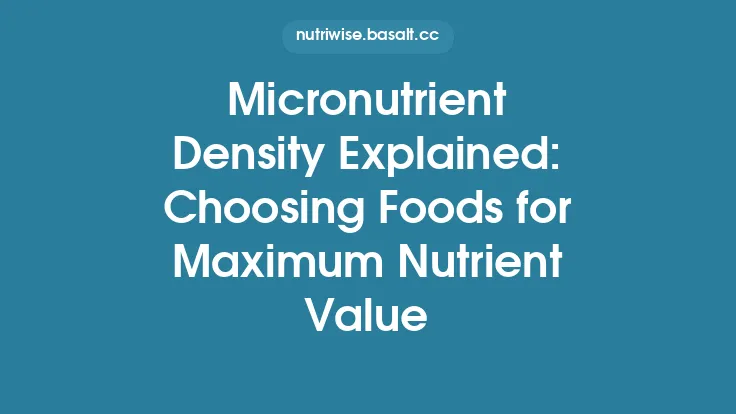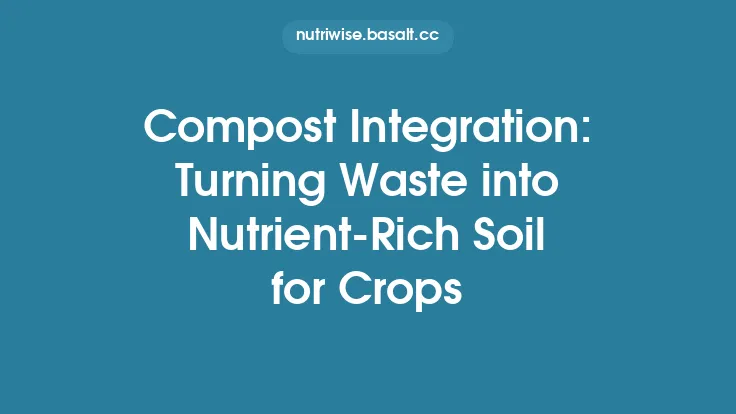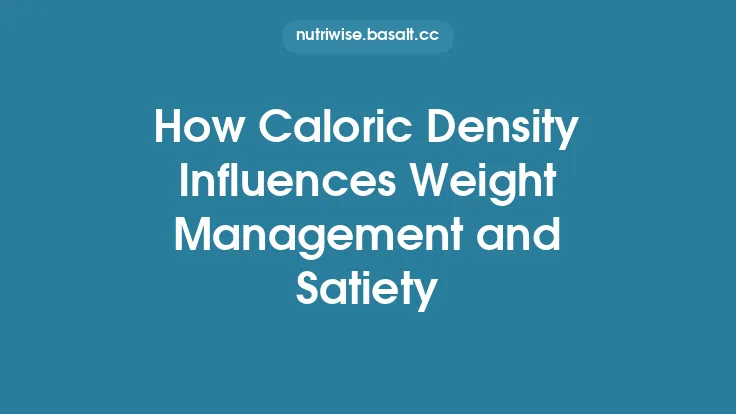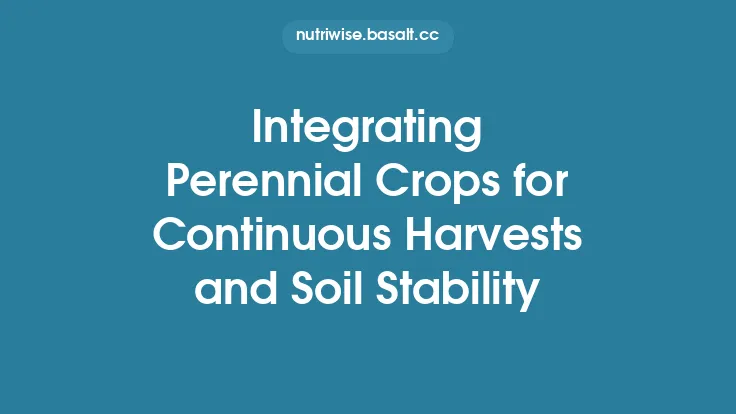Cover crops—often called “green manures” or “living mulches”—are more than just a seasonal filler between cash‑crop cycles. They are a cornerstone of regenerative agriculture, acting as a dynamic, living interface between the soil and the next harvest. By establishing a purposeful plant cover during fallow periods, growers can harness a suite of biological, chemical, and physical processes that rebuild soil structure, invigorate microbial communities, and ultimately translate into higher nutrient density in the foods we eat. This article explores the science behind those benefits, offers guidance on selecting and managing cover crops, and outlines practical ways to monitor progress while navigating common challenges.
Understanding Soil Health
Soil health is a holistic concept that integrates physical, chemical, and biological attributes. A healthy soil exhibits:
- Structure and Aggregation – Stable aggregates create pore networks for air and water movement.
- Organic Matter Content – Provides energy for microbes, improves water‑holding capacity, and supplies nutrients.
- Biological Activity – A diverse community of bacteria, fungi, nematodes, and arthropods that drive nutrient cycling.
- Nutrient Balance – Adequate levels of macro‑ and micronutrients, readily available to plant roots.
- pH and Cation Exchange Capacity (CEC) – Influence nutrient solubility and retention.
Cover crops directly influence each of these components, acting as a catalyst that accelerates the natural processes that maintain and improve soil health.
Mechanisms by Which Cover Crops Improve Soil Structure
- Root Penetration and Soil Loosening
The extensive root systems of many cover crops (e.g., radish, rye, and vetch) physically break up compacted layers, creating channels that increase bulk density and improve root penetration for subsequent cash crops.
- Organic Matter Accumulation
Above‑ground biomass that is later terminated adds fresh organic material to the surface, while root turnover contributes organic carbon belowground. This dual input raises total organic carbon (TOC) and builds humus over time.
- Aggregate Formation
Root exudates—sugars, amino acids, and organic acids—stimulate the production of extracellular polymeric substances (EPS) by soil microbes. EPS act as natural glues, binding soil particles into stable microaggregates that resist erosion.
- Soil Porosity and Water Infiltration
The macropores left by decaying roots enhance infiltration rates, reducing surface runoff and promoting deeper water percolation. While not a primary focus of water‑management strategies, this effect supports overall field resilience.
Biological Benefits: Microbial Activity and Mycorrhizal Partnerships
Cover crops serve as a living food source for soil microbes. Their influence on the biological dimension of soil health can be broken down into several key pathways:
- Stimulation of Bacterial Populations – Fast‑growing grasses such as annual ryegrass release copious root exudates that favor copiotrophic bacteria, which rapidly decompose organic matter and release nutrients like nitrogen (N) and phosphorus (P).
- Fungal Community Enrichment – Leguminous cover crops (e.g., clover, hairy vetch) support arbuscular mycorrhizal fungi (AMF). These symbionts extend hyphal networks beyond the root zone, increasing the absorptive surface area for phosphorus, zinc, and micronutrients.
- Nitrogen‑Fixing Bacteria – Legumes host Rhizobium spp. within root nodules, converting atmospheric N₂ into plant‑available ammonium. When the legume biomass is incorporated, the fixed N becomes part of the soil’s nitrogen pool, reducing the need for synthetic inputs.
- Disease Suppression – A diverse microbial community can outcompete pathogenic organisms through niche occupation and the production of antimicrobial compounds, a phenomenon known as “soil‑borne disease suppression.”
Nutrient Cycling and Enhanced Nutrient Density in Subsequent Crops
The ultimate goal for many growers is to translate improved soil health into more nutritious food. Cover crops influence nutrient density through several interconnected processes:
- Increased Soil Organic Matter (SOM) and CEC
Higher SOM raises the soil’s cation exchange capacity, allowing it to retain essential nutrients (K⁺, Ca²⁺, Mg²⁺) longer and release them gradually to plant roots. This steady supply supports the synthesis of vitamins, minerals, and phytochemicals in the harvested crop.
- Balanced Nitrogen Supply
Legume cover crops add biologically fixed nitrogen, while non‑legume grasses scavenge residual soil nitrate, preventing leaching. The synchronized release of nitrogen during the cash‑crop’s critical growth stages promotes protein synthesis and the accumulation of nitrogen‑containing phytochemicals such as glucosinolates and flavonoids.
- Enhanced Micronutrient Availability
Mycorrhizal colonization, spurred by cover crops, improves uptake of micronutrients like zinc, copper, and iron—elements directly linked to human health outcomes (e.g., immune function, cognitive development).
- Improved Phosphorus Use Efficiency
Root exudates and mycorrhizal hyphae mobilize otherwise inaccessible forms of phosphorus, reducing the need for external P fertilizers and ensuring that the cash crop can allocate phosphorus toward seed and fruit development, which are rich in phosphorus‑dependent compounds (e.g., ATP, nucleic acids).
Collectively, these mechanisms can raise the concentration of macro‑ and micronutrients in the edible portions of crops, a phenomenon documented in multiple field trials where cover‑cropped systems produced beans, tomatoes, and leafy greens with higher protein, vitamin, and mineral contents compared to conventional monocultures.
Choosing the Right Cover Crop for Your System
Selecting an appropriate cover crop hinges on climate, soil type, cash‑crop rotation, and specific soil‑health goals. Below is a concise decision matrix:
| Goal | Climate Suitability | Typical Species | Key Traits |
|---|---|---|---|
| Rapid Soil Cover & Erosion Control | Cool, moist | Winter rye, annual ryegrass | Fast growth, dense canopy |
| Nitrogen Enrichment | Temperate to warm | Hairy vetch, crimson clover, peas | Symbiotic N‑fixation, high biomass |
| Deep Soil Penetration | Warm, well‑drained | Daikon radish, turnip, forage radish | Taproots >1 m, “bio‑drilling” of compaction |
| Weed Suppression | Any (when timed correctly) | Buckwheat, mustard, sorghum‑sudangrass | Allelopathic compounds, rapid canopy closure |
| Mycorrhizal Stimulation | Broad | Crimson clover, alfalfa, oats | Strong AMF associations |
| Short‑Term Cover (e.g., 30‑45 days) | Warm | Mustard, phacelia | Quick germination, easy termination |
Considerations for Mixed Species
Combining legumes with grasses (e.g., rye‑vetch mix) often yields synergistic benefits: legumes supply nitrogen, while grasses provide biomass and soil protection. The proportion of each component can be adjusted based on the desired nitrogen balance and biomass production.
Practical Implementation Strategies
- Timing of Seeding
- Fall Seeding – Ideal for cool‑season grasses (rye, winter wheat) that establish before winter and provide early spring cover.
- Spring Seeding – Suited for warm‑season legumes (vetch, peas) that grow quickly during the early growing season.
- Seeding Rate and Method
- Broadcast Seeding – Simple for large fields; ensure uniform distribution with a calibrated spreader.
- Drill Seeding – Provides better seed‑to‑soil contact, especially for small‑seeded legumes.
- Rate Guidelines – Grasses: 60–120 lb acre⁻¹; legumes: 30–70 lb acre⁻¹; mixed blends: 80–100 lb acre⁻¹ total.
- Termination Techniques
- Mechanical – Mowing, rolling, or flail mowing; effective for most species and leaves a mulch layer.
- Chemical – Selective herbicides (e.g., glyphosate) may be used when rapid termination is required, but many regenerative practitioners prefer non‑chemical methods to preserve microbial activity.
- In‑situ Incorporation – Chopping and allowing the residue to decompose on the surface (no‑till) maximizes organic matter retention.
- Integration with Cash Crops
- Relay Planting – Overlap the sowing of the cash crop with the later growth stage of the cover crop, allowing the cover to continue providing benefits while the cash crop establishes.
- Strip Cropping – Alternate strips of cover and cash crops within a field to maintain continuous ground cover and reduce erosion.
- Equipment Considerations
- Use low‑impact implements (e.g., wide‑tine harrows) to avoid soil disturbance that could negate the structural benefits created by cover‑crop roots.
Monitoring and Measuring Success
To gauge the effectiveness of cover‑crop interventions, adopt a combination of qualitative observations and quantitative metrics:
- Soil Organic Carbon (SOC) Tests – Annual or biennial sampling to track changes in carbon stocks.
- Bulk Density Measurements – Use a core sampler to detect reductions in compaction over time.
- Microbial Biomass Carbon (MBC) – Laboratory assays (e.g., fumigation‑extraction) reveal shifts in microbial activity.
- Nitrogen Mineralization Rates – Incubation tests indicate how much plant‑available N is being released from cover‑crop residues.
- Plant Tissue Analysis – Compare nutrient concentrations (protein, micronutrients) in cash‑crop harvests from cover‑cropped versus non‑cover‑cropped plots.
- Visual Indicators – Observe improvements in soil color (darker, richer hue), reduced surface crusting, and increased earthworm activity.
Documenting these parameters not only validates the agronomic benefits but also provides data for continuous refinement of cover‑crop selections and management practices.
Common Challenges and Solutions
| Challenge | Underlying Cause | Practical Solution |
|---|---|---|
| Poor Germination | Inadequate seed‑to‑soil contact, moisture deficit | Use a seed‑to‑soil contact roller, pre‑wet seed beds, or apply a light irrigation at planting. |
| Weed Competition | Late planting or low seeding rates | Increase seeding density, select fast‑growing species, or employ a brief pre‑emergence herbicide if compatible with regenerative goals. |
| Termination Timing | Early termination reduces biomass; late termination may interfere with cash‑crop planting | Establish a clear termination window based on cash‑crop planting schedule; use a combination of mowing and rolling for efficient kill. |
| Nitrogen Imbalance | Overreliance on legume cover without sufficient non‑legume biomass | Incorporate a grass component to capture excess N and prevent leaching; monitor soil N levels to adjust species mix. |
| Pest Pressure | Certain cover crops can attract pests (e.g., aphids on legumes) | Rotate cover‑crop species annually, use trap crops, or integrate biological control agents. |
By anticipating these issues and applying targeted adjustments, growers can maintain a resilient cover‑crop system that consistently delivers soil‑health benefits.
Future Directions and Emerging Research
The science of cover crops is rapidly evolving, with several promising avenues that could further amplify their role in nutrient density:
- Breeding for Enhanced Root Exudates – New cultivars are being selected for higher secretion of organic acids that mobilize phosphorus and micronutrients, directly influencing the nutrient profile of subsequent crops.
- Multi‑Species “Living Mulch” Systems – Research into polyculture cover‑crop mixes aims to create self‑sustaining ecosystems where each species fulfills a niche (e.g., nitrogen fixation, deep rooting, pest deterrence), reducing management inputs.
- Precision Seeding and Remote Sensing – Drone‑based NDVI imaging can identify gaps in cover‑crop establishment, allowing site‑specific reseeding and optimizing biomass production.
- Soil Microbiome Engineering – Inoculation with beneficial microbial consortia (mycorrhizal fungi, nitrogen‑fixing bacteria) in conjunction with cover crops may accelerate the development of a nutrient‑rich rhizosphere.
- Linking Soil Health to Human Nutrition – Emerging metabolomic studies are correlating specific soil microbial metabolites with increased phytochemical concentrations in vegetables, opening pathways for “soil‑to‑plate” certification schemes.
These developments suggest that cover crops will continue to be a dynamic tool, not only for restoring soil function but also for delivering foods that are richer in the nutrients essential for human health.
In summary, cover crops act as a living bridge between the soil’s biological engine and the nutritional quality of the foods we consume. By improving soil structure, fostering a vibrant microbial community, and enhancing nutrient cycling, they lay the groundwork for crops that are both more resilient and more nutrient‑dense. Thoughtful selection, strategic implementation, and diligent monitoring enable growers—whether on large farms or small plots—to harness these benefits, contributing to a food system that is healthier for the planet and for the people who rely on it.





